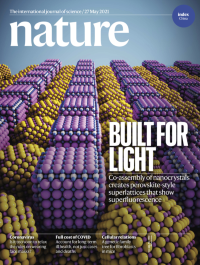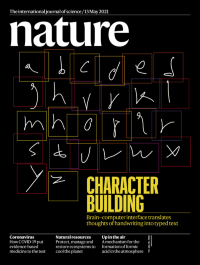Volume 593
-
No. 7860 27 May 2021
Built for lightNanocrystals of lead halides with perovskite-type structures have garnered a lot of attention as promising materials for optoelectronic devices such as displays. In this week’s issue, Maksym Kovalenko and his colleagues show that perovskite nanocubes can be assembled with other nanocrystals to form superlattices that have perovskite-type structures. The researchers assembled the nanocubes with spherical (pictured on the cover) or truncated cuboid nanocrystals to form the multicomponent superlattices. With a high degree of orientational order among the nanocrystals, these structures exhibit superfluorescence, which the team suggests could be tailored for use in ultrabright light sources.
-
No. 7859 20 May 2021
Joint ventureThe amino acids that make up a protein dictate its structure and function. But crosslinks between amino-acid residues introduce additional chemical modifications that affect how the protein behaves under different physiological conditions. The most common links are between two sulfur atoms, known as disulfides. In this week’s issue, Kai Tittmann and his colleagues report a hitherto unidentified linkage that forms between cysteine and lysine residues, involving nitrogen and sulfur being joined together by an atom of oxygen (pictured on the cover with nitrogen in blue, oxygen in red and sulfur in yellow). The researchers found that this N–O–S bridge acts as a regulatory redox switch that controls the activity of the transaldolase enzyme in Neisseria gonorrhoeae, the bacterium that causes gonorrhoea. The team also did some research on structures in the Protein Data Bank and suggest that the N–O–S linkage is likely to be found in many other protein families.
-
No. 7858 13 May 2021
Character buildingBrain–computer interfaces (BCIs) have the potential to restore communication to people who have lost the ability to move or speak. To date, the focus has largely been on motor skills such as reaching or grasping. In this week’s issue, Francis Willett and his colleagues present the results from an intracortical BCI that decodes attempted handwriting movements from neural activity in the motor cortex and translates it to text in real time. The researchers worked with a man who is paralysed from the neck down, asking him to try to write by imagining he was holding a pen on a piece of paper. The BCI used a neural network to translate the neural signals into letters, allowing the man to reach a writing speed of 90 characters per minute with an accuracy of 94.1%. The cover features aggregated images of the alphabet derived from the study participant’s neural activity as he thought about writing.
-
No. 7857 6 May 2021
Interred in AfricaThe cover image shows the reconstruction of the partial skeleton of a young child dating to around 78,000 years ago. The remains were uncovered at a cave site called Panga ya Saidi in coastal Kenya and studied by María Martinón-Torres and her colleagues, who describe the finding in this week’s issue. The discovery represents the oldest known deliberate burial of a modern human in Africa. Although it is known that Neanderthals deliberately buried their dead, there has been little evidence for the practice in early humans. The child, named ‘Mtoto’ (‘child’ in Swahili) by the team, was about 3 years old and was placed on their side with their legs drawn up to their chest. Mtoto was interred in a pit that seems to have been deliberately excavated, and was covered by sediment scooped up from the cave floor. The discovery of Mtoto sheds fresh light on how populations of the Middle Stone Age dealt with their dead.




